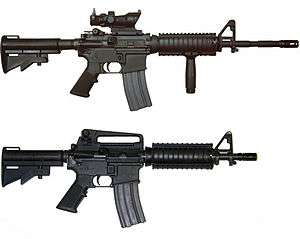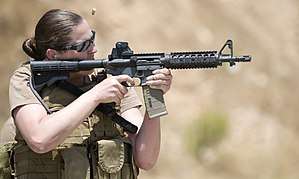Close Quarters Battle Receiver
The Close Quarter Battle Receiver (CQBR) is a replacement upper receiver for the M4A1 Carbine, developed by the US Navy. The CQBR features a barrel 10.3 in (262 mm) in length, similar to the Colt Commando short-barreled M16 variants of the past. This shorter barrel makes the weapon significantly more compact, which makes it easier to use in and around vehicles and in tight confined spaces. Special units such as commandos boarding ships and bodyguards for senior officers have found such shortened weapons very useful and use the CQBR.
| Close Quarter Battle Receiver[1] | |
|---|---|
 Top: An M4A1 with SOPMOD package, including Rail Interface System and Trijicon 4× ACOG. The barrel length is 14.5 inches (370 mm). Bottom: An M4A1 with a Close Quarter Battle Receiver. The barrel length is 10.3 inches (260 mm). | |
| Type | Carbine |
| Place of origin | United States |
| Service history | |
| In service | 2000–present |
| Used by | See M4 Carbine users |
| Wars | War in Afghanistan Iraq War |
| Production history | |
| Designer | Colt Defense |
| Designed | 1999 |
| Produced | 2000–present |
| No. built | Approx. >10,000 |
| Specifications (CQBR) | |
| Mass | 2.72 kg (6.00 lb) |
| Length | 762 mm (30.0 in) stock extended 679.4 mm (26.75 in) stock retracted |
| Barrel length | 262 mm (10.3 in) |
| Cartridge | 5.56×45mm NATO |
| Action | Gas-operated, rotating bolt |
| Muzzle velocity | 2,585 ft/s (788 m/s)[2] |
| Effective firing range | 328 yd (300 m) |
| Feed system | 20- or 30-round detachable STANAG magazine |
| Sights | Iron sights |
Its preliminary National Stock Number was 1005-LL-L99-5996; however, a complete CQBR-equipped carbine now has the NSN 1005-01-527-2288. The overall length of the upper receiver is 19.25 inches (489 mm). With the stock retracted, the overall length of the weapon is 26.75 inches (679.4 mm).
Background
The M4 carbine and M16 are not ideally suited for all missions, so it was proposed that the modularity of the M16 series would allow a user to replace the upper receiver of an existing weapon with one more suitable to the task. One of two proposed special mission receivers that were planned for inclusion into the SOPMOD Block II kit, the CQBR has taken off on its own. Like the proposed Special Purpose Receiver, the Close Quarters Battle Receiver has been more or less taken on by the Naval Surface Warfare Center, Crane Division (often referred to as NSWC-Crane or just "Crane") as its own project following the CQBR's removal from the SOPMOD program. Just as the Special Purpose Receiver morphed into the Special Purpose Rifle, and was type-classified as Mk 12 Mod 0/1, the complete CQBR-equipped carbine has been type-classified as the Mk 18 Mod 0, or the Mk 18 Mod 1 with a sightless gas block and full-length accessory rail kit.
The purpose of the CQBR remains to provide operators with a weapon of submachine gun size, but firing a rifle cartridge, for scenarios such as VIP protection, urban warfare, and other close quarters battle (CQB) situations. The CQBR is designed to provide improvement over previous AR-15/M16-type weapons in this category. The CQBR is usually issued as a complete weapon system, and not just an upper receiver. The CQBR was once only available to Naval Special Warfare units (and by extension, other US Special Operations Forces units), but the Mk 18 Mod 0 has become general issue for Visit, Board, Search, and Seizure (VBSS) missions and, as of 2006, for NCIS agents deploying to active combat zones. The Mk 18 is also used by the Coast Guard's Tactical Law Enforcement Teams and Maritime Security Response Teams and the United States Navy's Explosive Ordnance Disposal (EOD) Operators. It is also used by Marine Force Recon's CQB operators, and is in most cases the standard weapons of choice for said operators where the range and accuracy of an M4 is not necessary.
The short 10.3 in (262 mm) barrel length requires special modifications to reliably function. The gas port is opened from 0.062 to 0.070 in (1.6 to 1.8 mm). A one-piece McFarland gas ring replaces the three-piece gas ring set. The standard four-coil extractor spring is replaced with a commercial off-the-shelf (COTS) five-coil spring. An O-ring surrounds the extractor spring. The standard M4 flash hider has been replaced with the M4QD flash hider for suppressor compatibility.
Evolution
_team_aboard_the_guided-missile_destroyer_USS_Bulkeley_(DDG_84)_practice_essential_gun-firing_procedures_with_the_MK-18_rifle.jpg)
- CQBR type 1: Made from M4A1 uppers by shortening the barrels and opening gas ports, no longer produced, STD carbine buffer in use in host lowers at time of fielding.
- CQBR type 2: NSWC assembled with contracted and /or overhauled parts complete with all accessories to current standards at time of build, will work with H, H2 or H3 balanced to ammo requirements:
- H okay with M193/M855.
- H2 needed for MK 262/R2LP and will feed and fire M193/M855.
- H3 may be needed for an extreme case, or when the gas port is eroded but the barrel still groups.
- CQBR type 2A: NSWC assembled with contracted and /or overhauled parts, naked without any accessories or buffer. The buffer in the host carbine would be used or upgraded as necessary via the supply system same as type 2.
- CQBR type 3: Colt-contracted upper complete with all accessories. NO buffer supplied. The buffer in the host carbine would be used or upgraded as necessary via the supply system same as type 2.
- CQBR type 3A: Colt-contracted upper naked without any accessories or buffer supplied. The buffer in the host carbine would be used or upgraded as necessary via the supply system same as type 2.
- MK18 type 1: NSWC assembled carbine with contracted and/or overhauled parts complete with all accessories to current standards at time of build; will work with H or H2 and could have shipped with either. Units will balance buffer to ammo requirements:
- H okay with M193/M855. (All shipboard MK 18s should have H buffers as this was the standard at the time of assembly.)
- H2 needed for MK 262/R2LP and will run M193/M855.
- H3 may be needed for an extreme cases or when the gas port is eroded but the barrel still groups.
- MK18 type 2: Colt-contracted carbine complete with all accessories (H buffer supplied). Units will balance buffer to ammo requirements same as Mk 18 type 1.
- MK18 Mod 1: Similar to the changes found in the SOPMOD Block II kit, the Mod 1 features a gas block end without a front sight and a railed handguard, by Daniel Defense, that extends all the way to the base of the flash hider to provide more accessory rail space for the user.
- MK18 Mod 2: Simultaneously with USASOC's adoption of the Upper Receiver Group, Improved (URG-I), which featured the Geissele Automatic's MK16 rail with M-Lok interface, Special Operations community had requested Geissele to develop a 9.3-inch rail for their MK18's. In 2019, there were requirements for a 10.5-inch rail instead, because reevaluation found 11.5-inch barrels to work better than 10.3-inch series, and thus a longer rail is needed. Together with the regular 14.5-inch uppers, these are often unofficially dubbed "SOPMOD Block 3" by operators.
Specifications

_perform_a_live_fire_exercise_for_the_Secretary_of_the_Navy_(SECNAV)_The_Honorable_Dr._Donald_C._Winter.jpg)
- Upper and lower receivers: The lower receiver is a standard M4A1 lower receiver sometimes modified with the addition of a CQD RSM sling adapter plate. However, many CQBR rifles also use surplus M16A1 lower receivers. Internally, the CQBR also takes advantage of a larger gas port and modified bolt carrier and buffer assembly. The gas port has been opened to 0.070 in (1.8 mm). A number of Lewis Machine & Tool 10.5" (266.7 mm) upper receivers have also been reported to have been purchased for the CQBR program. These upper receivers feature a gas system optimized for short barrel use. The Mod 1 makes use of a forward sight delete and full-length handguard to provide more rail space for the user.
- Sights: Initially, detachable carrying handles cut down so that only the rear sight assembly was used. However, most of these have been replaced with the similar, commercially-made Lewis Machine & Tool adjustable rear sight. Also used are several types of reflex and magnified optics, most commonly seen is the Aimpoint CompM2 in a Wilcox Industries Corp. Picatinny (MIL-STD-1913) mount. On the Mod 1, the front sight is deleted and a full-length accessory rail is used; flip up iron sights may be mounted per user preferences
- Stock: A variety of M4 retractable buttstocks are used on a standard 4-position receiver extension, including the standard "CAR" stock. Most often seen is the SOPMOD stock, often referred to as the "Crane stock", created by Dave Armstrong of NSWC-Crane. The angled stock offers better cheekweld as well as providing two storage compartments for spare batteries. The stock must be removed from the weapon to access the storage compartments. The initial run of stocks was made by NSWC-Crane from glass fiber polymer. Because of this, they were somewhat fragile and did not always properly lock into the receiver extension. A rubber band was used to secure the latch so it would not slide out of the desired position. The current L7LA2B SOPMOD stocks are made by Lewis Machine & Tools and have none of these problems.
- Barrel: The CQBR uses a 1:7 in (178 mm) twist M4 barrel that has been modified in length to 10.3 in (262 mm). The diameter of the barrel under the handguards is 1.17 in (29.7 mm). The KAC M4-QD flash suppressor is fitted, allowing use of the KAC QDSS-NT4 suppressor (National Stock Number 1005-01-437-0324). Although it has a bayonet lug, the CQBR is not meant to be fitted with a bayonet.
- Handguards: The standard handguard for the CQBR is the Knight's Armament Company Rail Interface System (M4 Carbine RIS; National Stock Number 1005-01-416-1089), which is designed for a variety of barrel profiles and allows for the use of any MIL-STD-1913 tactical accessories such as the AN/PEQ-2 infrared pointer, SureFire flashlights, or a vertical forward grip.
The handguard manufacturer has since changed from KAC to Daniel Defense as the primary contractor for the MK18 RIS, NSN # 1005-01-548-1385.
- Ammunition: The CQBR is designed to use standard 5.56×45mm NATO 62-grain SS109/M855 FMJ and M856 Tracer ammunition. However, due to the short barrel, the heavier 77-grain Mk 262 cartridge is preferred. There are no plans to rechamber the weapon in any additional calibers.

References
External links

- NAVSEA CQBR PowerPoint presentation
- Wilcox Industries Corp.
- Small Arms Review